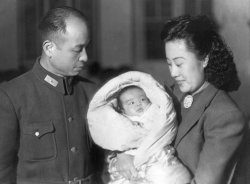
MAY CONTAIN NUTS

Search Shorpy
SHORPY ART

Framed or unframed, desk size to sofa size, printed by us in Arizona and Alabama since 2007. Explore now.
Join and Share
Ad-Free Shorpy
Shorpy is funded by you. Patreon contributors get an ad-free experience.
Learn more.

Recent comments
- Alas, hidden from view
- Exclusive pump
- Details, Details
- What's that building to the left of the tower?
- Coal Barges
- Bromo-Seltzer
- Inner harbor
- The Basin
- What a headache!
- Giant stepladder?
- Baldwin 62303
- Baldwin VO-1000
- Cold
- No expense spared
- Tough Guys
- Lost in Toyland
- And without gloves
- If I were a blindfolded time traveler
- Smoke Consumer Also Cooks
- Oh that stove!
- Possibly still there?
- What?!?
- $100 Reward
- Freeze Frame
- Texas Flyer wanted
- Just a Year Too Soon
- WWII -- Replacing men with women at the railroad crossing.
- Yes, Icing
- You kids drive me nuts!
- NOT An Easy Job
Member Photos
The Shorpy
Print Emporium
Print Emporium
Search Shorpy
Search results -- 30 results per page
- Night Train: 1943
- ... are like looking into a history book. Many washed out old color photos are the same.
These old Kodachromes take you back to the ...
(The Gallery, Kodachromes, Jack Delano, Railroads, WW2) ... Posted by Dave - 08/06/2012 - 10:57pm -
![Night Train: 1943 March 1943. The Santa Fe Yards at Argentine, Kansas. View full size. 4x5 Kodachrome transparency by Jack Delano, Office of War Information.
Wow, gorgeous.That's one for the desktop background. Talk about atmospherics.
Love it!Perfect exposure. I wonder how many takes it took him to get it right.
[This one took some Shadows & Highlights tweaking in Photoshop. - Dave]
A theory about the lightingThe exposure was fifteen minutes or so, but the railhouse lights were turned on for only a small portion of that. I can't figure out any other way you would see both the lantern-trail on the right and distinct figures in the house.
If so, I wonder if this was arranged with the yard workers. Did Jack Delano tell them to leave the lights off until he called down to them?
[Close up, we can see the figures in the railhouse (below) are a blur -- with a light trail from someone's cigarette. I don't think anyone was turning lights off or on. We know that some of Delano's nighttime exposures were around five to seven minutes. - Dave]
Very long exposureLook at the meandering light streak on the right, clearly a lantern or flashlight being swung in the hand of somebody walking through the frame. The shutter had to be open for several minutes at least for him to walk so far.
The more I look at this picture, the more I love it.
[Plus, a cigarette! See above. - Dave]
Night Train: 1943This looks like a painting. Look at the rail house the figures in it look painted not real
Railhouse Is...In case you are wondering just what the "railhouse" is, its a scale track that weighs freight cars when they are diverted on the track that runs just in front of the windows.
Time travel.You realize these old Kodachromes are time travel machines, don't you?
Old B/W photos are like looking into a history book. Many washed out old color photos are the same.
These old Kodachromes take you back to the instant they were made. You're standing right there, peeking in on others and half expecting them to look right back.
Night Train 1943Re: Kodachrome. I took a night photo in Rome in 1958 with ASA 10 Kodachrome. The camera was on a tripod, exposure was on the button at 30 sec. @ f 2.8. If this 4x5 was shot, say, at f8, it would have been, as Dave says, 5 to 7 minutes, plenty of time to record the lanterns of the walkers and the cigarettes of the men in the railhouse. Shooting with slow films was a challenge, but not as daunting as you might think. You could hand-hold in daylight, 5.6 at 1/60th, or even 1/100th in bright sun. My 50+ year-old Kodachromes are as good as new, but not so with Ektachromes, which are all red now, and Anscochromes, which have just faded away.
Probably east of 42nd StreetBased on the recently-posted photo at https://www.shorpy.com/node/14960 , I think this is on the east side of 42nd Street (the bridge in the background), looking west. The blur of white in the top center of this photo is from the light tower seen at the upper right of 14960, and the trees at the upper left in this photo seem to match the ones on the east side of 42nd Street (by the big warehouse) in 14960.
Today, there is a small shack, and a larger BNSF building, in the general area. http://maps.google.com/maps?ll=39.081542,-94.675506&spn=0.002361,0.00324...
(The Gallery, Kodachromes, Jack Delano, Railroads, WW2)](https://www.shorpy.com/files/images/1a34713u1.thumbnail.jpg)
- Wright Whirlwind: 1942
- ... Flying V," newsletter of Love Field's ferrying group and a color copy of photograph [1943 or 1944]. Gift of Mary Josephine Tilton, 1995. ...
(The Gallery, Kodachromes, Aviation, Howard Hollem, WW2) ... Posted by Dave - 08/09/2012 - 12:34pm -
![Wright Whirlwind: 1942 August 1942. Mechanic Mary Josephine Farley works on a Wright Whirlwind motor in the Corpus Christi, Texas, Naval Air Base assembly and repairs shop. View full size. 4x5 Kodachrome transparency by Howard R. Hollem.
My God.I'm sitting here looking at this beautiful woman, and then I realise ... 65 years ago.
Older than my motherYeah I'm 51 and whenever I look at these beautiful women I have to keep reminding myself that they were all born before my 79-year-old mother.
There's something about them though that makes them seem more in synch with our times than the women of say a decade later. Don't know what it is.
Mary JosephineThis is Joe Manning, of the Lewis Hine Project. I found this in the Archival Collection at Texas Woman’s University.
“Mary Josephine Farley Tilton, Letters, 1943-1944, 5 folders. Native of Aransas Pass, Texas. Worked as an engine mechanic and Link trainer instructor during World War II, then joined the Women Air Force Service Pilots (WASP), class 43-W-4. Later was commissioned in the Air Force. Served in Germany during the Korean War. Graduated in 1965 from Midwestern University with a B.S. Degree in Elementary Education and became a teacher. Letters (all photocopies), written to her family, document Tilton's experiences as a WASP trainee at Avenger Field Sweetwater, Texas, and a ferry pilot based at Love Field, Dallas, Texas. Also includes news articles and a copy of "The Flying V," newsletter of Love Field's ferrying group and a color copy of photograph [1943 or 1944]. Gift of Mary Josephine Tilton, 1995.
Mary JosephineThis touching photograph is quite similar to a painting by Norman Rockwell.
“Photography takes an instant out of time, altering life by holding it still.” Dorothea Lange
"65 years ago"Makes you want to go find a DeLorean and a flux capacitor.
Mary Josephine FarleyI am uploading a photo of her in her WASP uniform taken in 1943.
[Thank you, whoever you are! - Dave]
ColourizationInteresting with all the comments on colourization, that here is another colourized shot.
My first job in a photo studio was making prints for the artist downstairs to colourize. We would make a black and white print, and then "sepia tone" it (boy, that smelled). The sepia would add the warm tones to areas not painted. On the back of the print we would write all the colours to be used -- "complexion," "hair colour," "eye colour," "misc." She would then use transparent dyes to add the colour and varnish over it (or "fixative" in the later years).
(The Gallery, Kodachromes, Aviation, Howard Hollem, WW2)](https://www.shorpy.com/files/images/1a34879u_0.thumbnail.jpg)
- Goodbye: 1943
- ...
Greyhound/Kleenex answer I saw this photo in color. Almost. It just struck me how deeply ingrained in my consciousness are the blue & white color schemes of both the Greyhound bus and the classic Kleenex box. I imagine ... of my vintage.
(The Gallery, D.C., Esther Bubley, WW2) ... Posted by Dave - 09/13/2011 - 10:44am -
![Goodbye: 1943 April 1943. Washington, D.C. "Soldiers looking out the window of the bus just before leaving the Greyhound terminal." Medium-format nitrate negative by Esther Bubley for the Office of War Information. View full size.
Greyhound to BroadwayWith a fair amount of imagination, one could envision a musical screenplay inspired by this image: two young men from different sides of town, shipping off to war with great excitement and intrepidation. A friendship forged by the random expediencies of America's World War II home front. The plot would have to resist some obvious cliches, but it would have been a rather progressive screenplay circa 1959 with Sammy Davis Jr. and Jack Lemmon.
With apologies to Lewis CarrollWhy is a Greyhound bus like a Kleenex box?
Chomp.I dunno. Why is a Greyhound bus like a Kleenex box?
Photographer IncognitoTwenty-two year-old Esther Bubley was able to capture this candid image, apparently without the subjects being conscious of her presence. Would these soldiers not notice the modestly attractive young brunette wielding her camera? There's an intangible skill that the best photographers possess-- one that allows subjects to forget the camera and to be themselves.
[Esther and her flash camera took dozens of photos of these guys at the Greyhound station and aboard the bus. So they were probably aware of her presence. - Dave]
From Here to EternityCould this be Angelo Maggio after signing up in Hoboken?
Tools of War
Here's how a Bus in the U.S.A.
Helps win a Battle in Tunisia
(click to enlarge)
Greyhound/Kleenex answerI saw this photo in color. Almost. It just struck me how deeply ingrained in my consciousness are the blue & white color schemes of both the Greyhound bus and the classic Kleenex box. I imagine it holds true for many others of my vintage.
(The Gallery, D.C., Esther Bubley, WW2)](https://www.shorpy.com/files/images/8d27129u.thumbnail.jpg)
- Langley Field: 1942
- ... G.I., but wing-tips? Weren't there rules beyond the color specification of brown?
Langley Crew I'm curious about how these ...
(The Gallery, Kodachromes, Alfred Palmer, Aviation, WW2) ... Posted by Dave - 08/30/2012 - 3:28pm -
![Langley Field: 1942 May 1942. "Here's our mission." A combat crew receives final instructions just before taking off in a mighty YB-17 bomber from the bombardment squadron base at Langley Field, Virginia, nation's oldest air base. View full size. 4x5 Kodachrome transparency by Alfred Palmer for the Office of War Information.
ShoesIs the second man from the right wearing wing-tip shoes? Looks like it to me. I know officers had to buy their own uniforms, so their uniforms weren't necessarily G.I., but wing-tips? Weren't there rules beyond the color specification of brown?
Langley CrewI'm curious about how these fliers were illuminated for this photo. Car headlights? It brings to mind the Montana cowboys photo seen previously on Shorpy.
[Below, a glimpse of Alfred Palmer's floodlight. - Dave]
Stunning imageThe composition and lighting in this photo are beautiful.
Pinks and brown shoesI agree, although I've heard that old school pilots (pre WW-II) would buy a pair of cowboy boots upon graduation from UPT. Seems like the flight engineer, or whoever has the greasy overalls, is wearing boots with undershot heels. FYI pinks is a term used for the tan twills used up to the 60's. They seemed to take on a pinkish cast in some light.
(The Gallery, Kodachromes, Alfred Palmer, Aviation, WW2)](https://www.shorpy.com/files/images/1a35094u.thumbnail.jpg)
- Killer B: 1942
- ... theatre, it was a wise choice. Admittedly, it's a great color for the Kodachrome format.
Caption CX I'm suremit's in the ...
(The Gallery, Kodachromes, Alfred Palmer, Aviation, WW2) ... Posted by Dave - 07/27/2012 - 12:18pm -
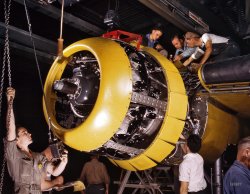
- 1,200 Horses: 1942
- ... Blue"
Kodachrome Colors Is the intense blue sky color a characteristic of Kodachrome transparencies? The other colors are so ...
(The Gallery, Kodachromes, Alfred Palmer, Aviation, WW2) ... Posted by Dave - 08/30/2012 - 3:27pm -
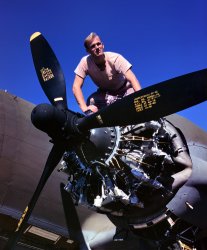
- Teamwork: 1942
- ... you say? what?
Great picture! The composition, the color - just a beautifully composed shot.
Riveting! I just had to say ... then.
(The Gallery, Kodachromes, Aviation, Factories, WW2) ... Posted by Dave - 03/19/2016 - 10:05am -
![Teamwork: 1942 October 1942. "Men and women make efficient operating teams on riveting and other jobs at the Douglas Aircraft plant, Long Beach, Calif. Most important of the many types of aircraft made at this plant are the B-17F 'Flying Fortress' heavy bomber, the A-20 'Havoc' assault bomber and the C-47 heavy transport plane shown here for the carrying of troops and cargo." 4x5 inch Kodachrome transparency by Alfred Palmer for the Office of War Information. View full size.
What? What?What did you say? what?
Great picture!The composition, the color - just a beautifully composed shot.
Riveting!I just had to say it: This is a riveting photo! ;-)
I love the chiaroscuro, the focussed concentration, the saturated colors, the flesh tones and the gray metal.
They are both beautiful people, too!
MOM!No comment necessary
Blatantly, Utterly PosedTechnically, it's a great feat of photography, but, like many Office of War Information photos, this image is blatantly and utterly posed.
Look at how the supposed "Rosie" is dressed, right down to gleaming shoes. Do you think for a moment that even the most unsophisticated viewer would not instantly recognize this as propaganda ?
Would it not be more informative to have captured the way the work was actually being conducted ? Would that not instill greater appreciation of the war effort in the general public?
On the plus side, the models are at least holding the rivet gun and the bucking bar in the correct alignment.
[These photos were used to produce posters and other promotional materials intended to motivate women to work in war-related industries; in other words, advertising, not documentation. -tterrace]
C-47Dad flew as aerial engineer / crew chief on C-47's in the Pacific War. Battle Stars for Guadalcanal and Northern Solomons. His unit, the "Thirsty 13th" Troop Carrier Squadron island hopped for almost 4 years. Places and air strips long since forgotten.. Dumbea, New Hebrides, New Caledonia, Espiritu Santos, etc. . C-47's were unarmed, flew low and slow, frequently to airstrips carved out of the jungle at the front lines (ie Guadalcanal). His unit lost aircrews. Also, heavy experience with malaria (take your Atabrine !!) and combat fatigue. C-47's were also used to tow gliders to the front lines. Dad made the Sep 7 1942 cover of Life in a "war glider". Dad never discussed much of his experience, but made sure we remembered his lost friends. Mom served in the Atlantic. Greatest generation indeed.
This photo series... famous, yes posed, but served an important function. Front line airmen depended on the manufacturing excellence portrayed in the series.
Posed? Of course!Made a pretty decent living taking photos like that. They were posed because the people who were paying me to take them wanted them that way. The shot we're discussing here is a beaut. Alfred Palmer made what could have been a snoozer most compelling.
When I was taking photos for newspapers, I still would, depending on the situation, ask the subjects to move this way or that way, so you could say those were posed, too. Most of the stuff I shot captured students of the month or new garden club officers. I wanted the subjects, who would be happy to be in the next edition of the paper, to look nice and for the photo to reproduce well as 65dpi black-and-white printed on newsprint.
Sports stuff, crime (what little I ever took) stuff: not posed but not always good, either!
Posed or not...Yes, it's obvious that the photo was posed. As tterrace noted, this and other similar photos seen here on Shorpy were used to create posters and other paraphernalia for the War effort.
But... My Grandmother worked in an aircraft plant during the War. She worked on an assembly team, not riveting but an equally taxing and dirty job. She had several photos I've seen that showed her daily outfits and for the most part it looks like she always tried to look her best, at least in the morning. She actually wore her hair the exact same way.
Yeah, there were (and still are) a lot of dirty jobs but you only have to peruse the photos in Shorpy for a bit to tell that people took the time to dress better, more formal back then.
(The Gallery, Kodachromes, Aviation, Factories, WW2)](https://www.shorpy.com/files/images/SHORPY-1a35338u.thumbnail.jpg)
- Air Raid Rules: 1942
- ... real maple syrup, no high fructose anything or caramel color at that time.
Nice going, kids. Now you'll have nothing to read in ... CA
(The Gallery, Fritz Henle, Kids, Stores & Markets, WW2) ... Posted by Dave - 07/16/2014 - 2:55pm -
![Air Raid Rules: 1942
What to Do — What Not to Do
This war is not like any other. It may reach your street -- your home -- at any moment. You may be fighting in this war tomorrow, or next week, or next month. Your government asks of you one simple thing, but one very important thing ... Learn and remember what to do if enemy planes and bombs come.
July 1942. "West Danville, Vermont. Guy Davenport, 11, and Maynard Clark, 14, reading the air raid instructions posted in Gilbert S. Hastings' post office and general store." Photo by Fritz Henle, Office of War Information. View full size.
And on the rack . . .Feature Comics #53 (February 1942) and True Comics #12 (May 1942).
The storeThe place still exists as a general store/post office run by the same family.
View Larger Map
There is a clip online about the 100 year anniversary of the store made by a local news program.
Learning fearEven as a preschooler at that time, I knew I was in danger if the "air raid" sirens were going off and we were trained to get under a table, shut off all lights and be perfectly quiet.
We lived in a very industrial small town in Connecticut full of factories which manufactured a huge number of defense weapons and war supplies of all kinds, so were considered vulnerable. No fun being seriously in fear of dying at that age.
Luckily, it did not happen and I am still here, spending way too much time on Shorpy and obsessed with life in the past.
Actually it is the only place I can go back to with real pictures illustrating familiar objects no longer available to be able to reconnect with the way it was. My mom used Rinso, we had the coral bars of Lifebuoy soap and gallons of real Vermont maple syrup were close by for New Englanders. These pics are unexpected treasures, thanks Shorpy.
Norman Rockwell sceneI thought that was a Norman Rockwell painting when I first saw it.
Air raid daysI remember my mother talking about air raid drills in Beaumont, Texas during the war [she was 4 years old when Pearl Harbor was attacked]. Despite the "women crying and thinking this was it", she found the whole experience pretty exciting. Beaumont was home to shipyards and oil refineries so it would have been a prime target for any Axis bombers.
Later in the war, she said that they were told not to pick up anything they saw in the street, "not even an empty Coke bottle"--they found out after the war that this was a reaction to the Japanese balloon bombs that killed several people in the Pacific Northwest early in 1945.
I know this place!Just up the road from here, on Molly's Pond, was the business of my uncle, Albert ("Al") W. May, known as "The Man in the Derby Hat." He was an auctioneer, antique dealer, antique reproduction furniture maker, maple syrup maker, and sawmill owner. Meanwhile, my aunt Velma ("Val") May ran a lunchroom in the auction barn on Saturday nights. She made the best bread I've ever tasted.
When I was small, we would stay at their place, but it later years we'd stay at Injun Joe Cabins, just around the corner from here. On my last visit, in 1979, I swam in Joe's pond. It was cold, clear, and wonderful. I never heard mention of the Davenport or Clark families, but I'm sure that my aunt and uncle knew them.
Three sizes of maple syrupIn the metal cans under the poster. We know with 100% certainty that the contents back then were real maple syrup, no high fructose anything or caramel color at that time.
Nice going, kids.Now you'll have nothing to read in the shelter.
Young Mr ClarkMaynard Roy Clark Jnr was born on January 3rd 1928 in Easton NH, the son of Maynard Snr 1894-1956 and Dora Greenwood 1900-1989, he was the 4th of 9 children.
On September 9th 1945 he married Marion Isobel Simpson in St Johnsbury,VT with the couple having to undergo a blood test on August 14th of that year (Was this a Vermont Law?)
I believe they had two children Judy Anne b March 10th 1946, and Thomas Jeffery b 25th October 1949.
Maynard died on 14th June 2008 in San Jose CA
(The Gallery, Fritz Henle, Kids, Stores & Markets, WW2)](https://www.shorpy.com/files/images/SHORPY-8d36045a.thumbnail.jpg)
- Roger the Riveter: 1942
- ... look at the "wooden" wing ribs and saw that despite their color they are aluminum. At first glance they looked to be made of solid ...
(The Gallery, Kodachromes, Alfred Palmer, Aviation, WW2) ... Posted by Dave - 06/19/2017 - 2:31pm -
![Roger the Riveter: 1942 October 1942. "Riveter at work at the Douglas Aircraft plant in Long Beach, California." Kodachrome transparency by Alfred Palmer. View full size.
Outta Time"Roger" looks very 1965, like he's gonna be hitting the surf as soon as work's done.
Thought it had to be a trainer ...Until I took a closer look at the "wooden" wing ribs and saw that despite their color they are aluminum. At first glance they looked to be made of solid birch, which would make the plane a trainer or, at its most ferocious, a light observation or liaison aircraft.
Across the pond, the Spitfire was supposedly based heavily on wooden members in its construction, though to what degree I cannot hazard a guess. And then there's America's Spruce Goose, genuinely unique and an anomaly almost before construction began. But I don't believe any first-line fighters or bombers in the US inventory during World War II had wooden structural members.
Always open to having my misconceptions corrected, of course.
Airplane?I'm a little at a loss what airplane this would be for.
The wing shape is for a low speed airplane, and it's awfully small, and not tapered in chord; and there are no attachment points at the root.
Not bucking for a promotionThis appears to be a staged photo, as he's not standing up, holding a bucking bar on the inside, and I don't see another worker holding a bucking bar. The rivets he's driving are AN426 (the AN stood for Army/Navy) 100 degree countersunk aluminum rivets. Today they're designated MS20426, the MS standing for Mil-Spec. I got to drive and buck both these and the round head AN470 (later MS20470) rivets, in high school in the '70s.
The countersunk rivets required a special countersinking bit, or, in some cases (small parts), the metal was stamped to the required 100 degrees.
[To quote Dave: [As we have pointed out elsewhere, most of the Palmer photos were posed. Some were used as studies by illustrators painting recruitment and bond drive posters. - Dave] -tterrace]
(The Gallery, Kodachromes, Alfred Palmer, Aviation, WW2)](https://www.shorpy.com/files/images/SHORPY-1a35353u2.thumbnail.jpg)
- On the Grid: 1942
- ... are made on a large board with pegs in it, running wire color A from point B to C around the pegs in the right path, and then roped ... perfectly.
(The Gallery, Andreas Feininger, Aviation, WW2) ... Posted by Dave - 08/12/2014 - 8:25am -
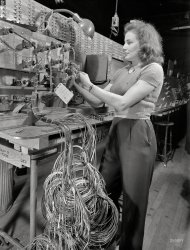
- Men Smoking Together: 1942
- ... states "Socks should conform as nearly as possible to the color of the shoes with which worn."
The Marine on the right with the rifle ... have reflective strips on them.
(The Gallery, Mining, WW2) ... Posted by Dave - 06/23/2015 - 9:35pm -
![Men Smoking Together: 1942 October 1942. "War production drive. Anthracite rallies. Servicemen working together! Soldiers, sailors and marines went into Pennsylvania mines during the anthracite rallies, September 30th through October 1st, and saw how hard coal is extracted from beneath the earth's surface." 4x5 nitrate negative by William Perlitch for the Office of War Information. View full size.
Spotless!This must be before they went into the mine.
Fill flashI wonder what kind of fill flash Bill was using. It was a powerful one, based on the second set of shadows that rival those of the sun. BTW, kinda looks like Cagney in the center of the poster.
Not Red Sox, but Bad SoxSomething we take for granted: male hosiery that stays in place around the ankle. Back in the day, not so true from the evidence of this pic.
Well BeltedAs a former Marine, I can't help but notice the contrasting belts on the two Marines and wonder what they signify. They are both in service A uniforms, but lack the green cloth belts around the waist that I remember. These days the black leather belt is worn only by senior drill instructors in recruit training. The white belt is a mystery, perhaps some sort of cartridge belt that canteens etc. might have been clipped on. Green versions of such belts were worn by duty officers/nco's. Hopefully some historian of military regalia can clear this up.
Regarding the hosiery, you will never see drooping socks on a Marine these days. They wear elastic suspenders connecting socks to shirt which are known as shirt stays and serve the twofold purpose of keeping socks up and shirt taut. Uniform regulations were slack back then, and hair was much longer.
It's The PitsAccording to the regulations of that period, the Marine on the left who is sporting the Expert Rifleman badge (both Marines have a Marksmanship Badge on the left with an unreadable qualification bar above it), is wearing the Winter Service, A uniform with the correct shell cordovan [shoe leather] dress belt, having placed the "buckle at the center of the waist in front, plate or buckle covering bottom button of coat." The cloth belt replaced it in 1943. However, he falls down on Special Regulation 62.e. which states "Socks should conform as nearly as possible to the color of the shoes with which worn."
The Marine on the right with the rifle Sharpshooter badge is wearing a fabric miner's pit belt (which bears a strong resemblance to a military M1917 Garrison Belt), while the sailor wears a leather pit belt.
Pit beltsThanks for the uniform info, Tobacconist. I was also confused about the Marines' belts.
Are the "miner's pit belts" associated the electric head lamps on the hardhats? I notice that the two guys at right have both lights and pit belts, while our Marine at left is wearing his leather belt and a hardhat -- but no lamp.
Trivia, I know. But fascinating to us history-types.
BeltedThe miner's belt was used to hold the battery for the miner’s cap lamp, and sometimes as a safety harness to prevent falls. Today it is also used to carry a gas detector, a portable respirator (self-rescuer), and possibly a tool pouch—but no longer serves as a stand-alone safety harness as most jurisdictions require a full body harness for that purpose. Available with or without suspenders or lumbar support, both the web and the leather styles are still used. The Amish make one of the most popular leather belts.
Rounding out the rest of the modern safety equipment are steel toed boots, ear plugs, safety glasses, gloves, and of course the hard hat with cap lamp. The clothes are made of heavy cotton worn under flame-resistant overalls that have reflective strips on them.
(The Gallery, Mining, WW2)](https://www.shorpy.com/files/images/SHORPY-8b08644a.thumbnail.jpg)
- Round House: 1943
- ... it through the epaulet on your jacket.
If this was in color the uniforms would probably look more alike. The variation is most likely ... the enlisted uniform was consistently of a more drab brown color that didn't have these variations.
(The Gallery, WW2) ... Posted by Dave - 03/31/2014 - 7:31am -
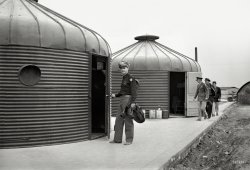
- Red and Blue: 1942
- ... overhauled by Instrument Pro and screened with "radium color" print and logo. Cessna 310 wheels & brakes, Wheel pants, Locking ...
(The Gallery, Kodachromes, Aviation, John Collier, WW2) ... Posted by Dave - 02/08/2008 - 10:48pm -
![Red and Blue: 1942 June 1942. Bar Harbor, Maine. Plane of Coast Patrol #20 at the Civil Air Patrol base. View full size. 4x5 Kodachrome transparency by John Collier.
That plane isA Waco YQC-6 [NC16576] (1936).
Here's another view:
This aircraft still fliesI found a sale listing for this Waco (current on Oct. 9, 2011) on the site of the American WACO Club. I like the site motto, "After the last WACO gracefully flies, the sky will become merely air."
For Sale: 1936 Waco YKS-6 NC16576. TTAF 1344 26 hours since complete restoration by Russ Harmuth to specs and condition of original factory delivery order. Log books. 245hp Jacobs R755-9, MOH by Aero Engines, HamStd 2B-20. Engine operating and maintenance manual. "Eyeball" air vents. AmeriKing ELT, TDR Txpdr, Garmin GNC 250 GPS/COM. PS Engineering PM1000 II, Back lit panel. Instruments overhauled by Instrument Pro and screened with "radium color" print and logo. Cessna 310 wheels & brakes, Wheel pants, Locking tail wheel,
Grimes retractable landing lights. Original nav lights. Strobes. Poly Fiber Waco vermillion w/ correct black trim. Grey velour interior. Original rear seat. Original NC registration number on tail and wings. Original operable speed brakes. O'hauled Curtiss-Reed prop available. $120,000.
(The Gallery, Kodachromes, Aviation, John Collier, WW2)](https://www.shorpy.com/files/images/1a34551u1_0.thumbnail.jpg)
- Trainlight: 1943
- ... been among the earliest photographers of light trails in color.
Blackout lights Weird to think there were blackout regulations in ... Gallery, Kodachromes, Jack Delano, Los Angeles, Railroads, WW2) ... Posted by Dave - 08/30/2012 - 3:30pm -
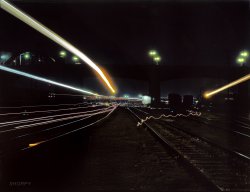
- Social Media: 1943
- ... paper would come wrapped in multiple pages of glorious color comics and just scanning through it would take until lunchtime.
In ... personal independence.
(The Gallery, Esther Bubley, WW2) ... Posted by Dave - 06/07/2016 - 12:27pm -
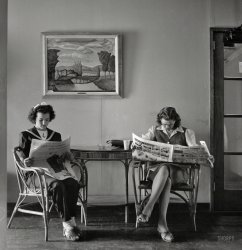
- Green for a Night: 1944
- ... operated by the CIO Women's Auxiliary, were for men of one color only. There, with servicemen and hostesses of both races, no friction ... Fall 1995.
(The Gallery, D.C., Joseph Horne, Music, WW2) ... Posted by Dave - 09/09/2011 - 2:31pm -
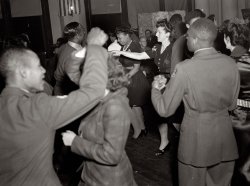
- Top Guns: 1945
- ... DeVilbiss spray.
Satisfaction Guaranteed “Any color you want as long as it’s Battleship Gray.”
(The Gallery, Found Photos, WW2) ... Posted by Dave - 11/03/2017 - 4:04pm -
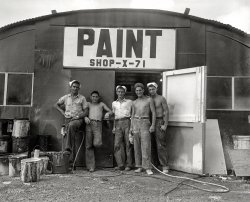
- Fort Belvoir: 1943
- Engineers' color guard at Fort Belvoir, Virginia. March 1943. View full size. 4x5 ... unknown.
(The Gallery, Kodachromes, Patriotic, WW2) ... Posted by Dave - 08/03/2012 - 10:10pm -
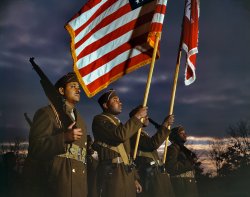
- WW2 Kodachromes
- WW2 KODACHROMES
Below, a selection of 1940s color transparencies, three of them the large-format 4x5's that we love so much ... Posted by Dave - 10/16/2007 - 3:52pm
- Great Aunt and Uncle
- ... think this is a portrait our great aunt and uncle during WW2/Sino-Japanese War and the Chinese Civil War. We don't know the city or any ... contrast between the triangle on the collar and the field color of the insignia makes me think it might be Maj. General in the Chinese ... Posted by citybeautiful - 11/16/2012 - 9:21pm -
